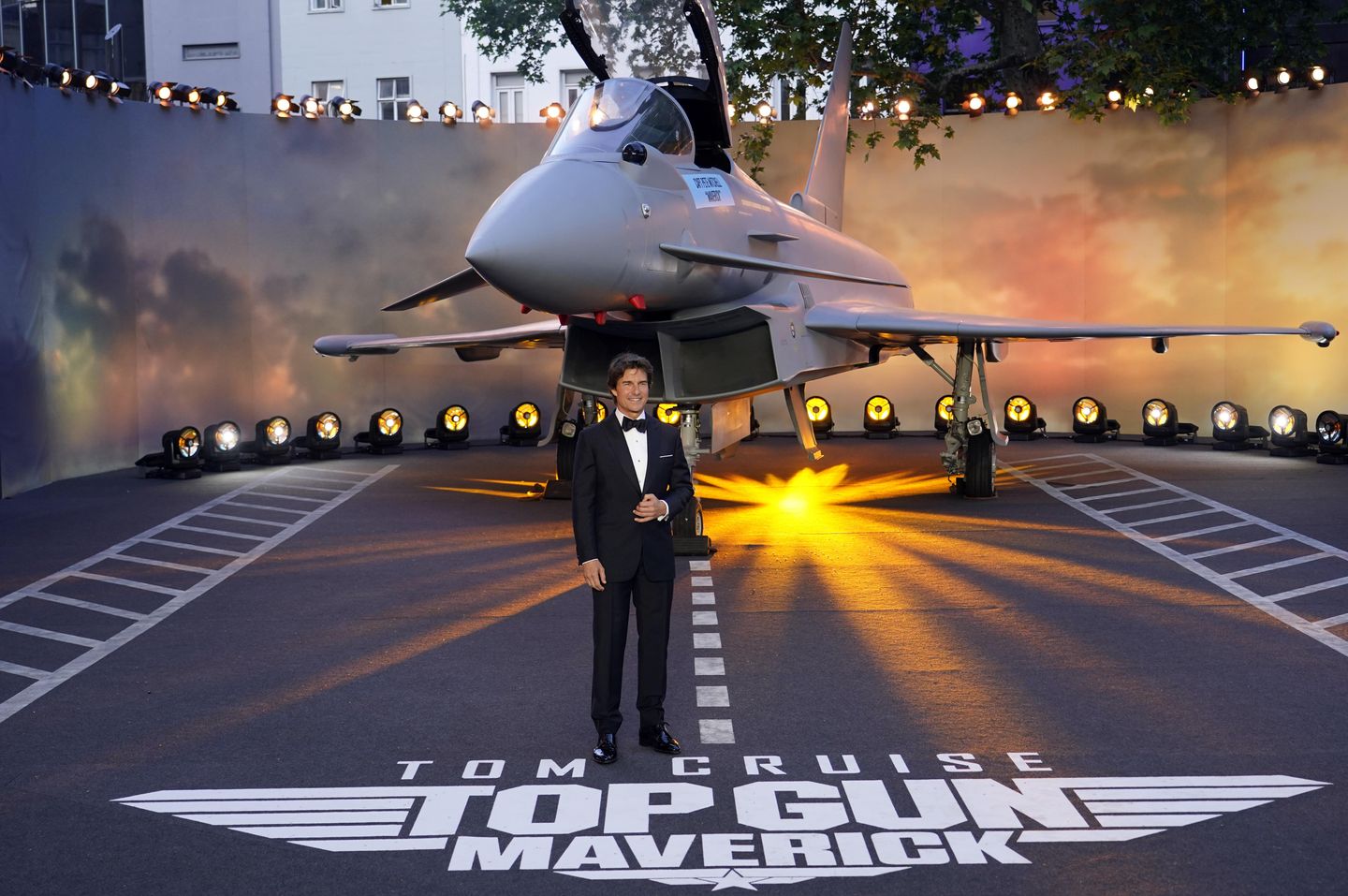

Sleek jet fighters streak into the sun, with the pilots of the F-35 Lightning IIs and F-22 Raptors pulling heavy Gs as they perform high-speed maneuvers against an unseen enemy. Meanwhile, helicopters and bombers take on a high-value target on the ground, destroying it in a fiery explosion.
“The entire sky belongs to us,” a deep voice announces.
That may sound like a scene from “Top Gun: Maverick,” the world box office topping blockbuster sequel to the classic 1980s movie “Top Gun,” but it’s actually from a U.S. Air Force recruiting commercial that runs before the film in theaters across the U.S.. As virtually everyone knows by now, Tom Cruise reprises his role as Capt. Pete Mitchell (call sign: Maverick), now an aging naval aviator assigned to train a group of junior pilots to attack a nuclear target in an unidentified country. The film has grossed almost $300 million less than two weeks after its release.
And U.S. military recruiters, facing what some say is the toughest market for prospects since the end of the Vietnam War, are hoping to pounce once again on the surge of patriotism and adrenaline inspired by the movie.
“The intensity of this [commercial] is stunning so hold on to your popcorn because we are bringing the Air Force to your seat,” Maj. Gen. Ed Thomas, commander of the Air Force Recruiting Service, said in a statement. “We want to get Americans excited about what it means to serve this great nation.”
The release of the original movie in 1986 made life in the Navy seem to be a glamorous, high-octane thrill ride. Following its release, applications to become naval aviators reportedly jumped by 500%. Then, as now, some canny recruiters set up information booths right outside theaters to woo those still high on the action they had just witnessed inside.
“That is why the Navy helps support such projects as the original ‘Top Gun’ and ‘Top Gun: Maverick,’ within operational constraints and at no additional cost to the taxpayer,” said Commander Dave Benham, a spokesman for the Navy’s recruiting command. “We think ‘Top Gun: Maverick’ will certainly raise awareness and should positively contribute to individual decisions to serve in the Navy.”
In the original movie, Tom Cruise played a cocky, hotshot fighter pilot who was sent to the Navy Fighter Weapons School near San Diego — nicknamed Top Gun — to hone his aerial dogfighting skills, when he wasn’t romancing his instructor or joining fellow shirtless pilots in a sweaty game of volleyball.
“Top Gun” came out at a time when the grim specter of Vietnam was dimming and confident Reagan-era patriotism was on the ascent. It was released the year Gen. Charles Brown, the Air Force Chief-of-Staff, graduated from pilot training.
“It was probably the most realistic flying movie that I had seen. It just left a mark on me,” Gen. Brown recalled at an August 2021 event at the National Press Club.
There are some skeptics who say the impact of the original 1986 on final recruiting numbers was overblown; despite the interest and profits generated by the film, final recruitment numbers were up only modestly.
The Navy says it needs to recruit more than 40,000 enlisted sailors and 3,800 officers into their active and reserve components this year, a job made harder by a historically competitive American job market. It is far too early to say whether the new “Top Gun” movie will help boost the Navy’s recruiting numbers, officials say. There are simply too many factors, such as the economy and the world’s political situation at any one time, that factor into someone’s decision to enlist in the armed forces.
Navy Capt. Brian Ferguson was the technical advisor for “Top Gun: Maverick,” charged with ensuring aerial authenticity and making sure the Hollywood actors didn’t break any of the Navy’s costly F/A-18 Hornets. He didn’t know if the original movie led to an avalanche of new sailors.
“I will tell you that it definitely had an effect on recruiting if only one guy, which is me,” Capt. Ferguson, a 28-year Navy veteran, told the New York Post. “I saw the movie [and] thought it looked like the most exciting job in the world. And it is.”
And the success of “Top Gun” reportedly also resulted in an increase in applications to the U.S. Naval Academy, the Air Force Academy, and West Point.
Navy officials aren’t surveying enlistees on whether “Top Gun: Maverick” or any other movie played a role in their decision to join.
“Some recruiters are working with local theaters for opportunities to share information with the public about the Navy and naval aviation,” Commander Benham said. Recruiters could be seen at one Northern Virginia multiplex theater last week, sitting behind a table with patriotic bunting and looking to engage any moviegoers who might suddenly be considering military service.
In 1986, the producers of “Top Gun” paid the military almost $2 million for the use of Miramar Naval Air Station, four aircraft carriers and about two dozen jet fighters, ranging from F-14 Tomcats to A-4 Skyhawks.
Even as external threats from adversaries like China and Russia mount and the U.S. continues reestablishing its former military presence in Europe, America’s ability to recruit sufficient volunteers to fully staff its armed forces is facing serious strains.
Gen. Thomas, the Air Force recruiting chief, said this year’s personnel market has been the toughest in more than two decades. He said it’s ultimately about the math: Fewer people today have a connection to a military veteran and eligibility to join the armed forces has dropped to just 23% due to obesity, medical issues and other concerns.
“The national labor shortage is driving millions of unfilled jobs. The nation is bigger [and] the military is smaller,” Gen. Thomas said. “Less people are generally knowledgeable enough about the military to know what a great way of life serving … can be.”
